#Scaffolding Sutton
Explore tagged Tumblr posts
Text

Looking for top quality roofing and scaffolding services. We provide quality services at such a affordable price.
0 notes
Text
https://desiscaffolding.co.uk/
Scaffolding in Sutton - Desiscaffolding | Call us for more info 079494 96109

For all your construction, renovation, and maintenance needs requiring dependable access solutions, Desiscaffolding is your leading expert for Scaffolding in Sutton. We are committed to providing top-tier scaffolding services that prioritize safety, efficiency, and customized solutions for a wide range of projects, whether residential, commercial, or industrial.
At Desiscaffolding, our unwavering focus is on delivering secure and robust scaffolding structures. Our highly skilled and certified team adheres strictly to the latest industry standards and safety regulations, ensuring every component is meticulously erected and dismantled. This commitment guarantees a safe working environment for your crew and the public. From intricate designs for multi-story developments to straightforward access for property repairs, we tailor our scaffolding solutions to meet the precise demands of your project, ensuring seamless progress and optimal productivity.
We offer a comprehensive suite of scaffolding services, including temporary roofs, shoring, access towers, and bespoke systems for challenging architectural requirements. With a reputation for reliability, punctuality, and a client-first approach, Desiscaffolding ensures your project stays on track and within budget. When you need dependable Scaffolding in Sutton, choose Desiscaffolding for a partnership built on trust and excellence. Contact us today to discuss your project requirements and receive a detailed, no-obligation quote.
Call us for more info 079494 96109
0 notes
Text
Rough timeline of the discovery of genes and DNA
(mostly condensed from the first half of S. Mukherjee, The Gene: An Intimate History, 2016, and this 1974 paper)
1857-1864: Gregor Mendel experiments with breeding peas at the monastery of Brno. The results show that information about flower color, pod shape etc. is transmitted in discrete blocks that do not mix, and can persist unexpressed in a generation to manifest again in the next.
1865-1866: Mendel's results are published in a minor journal and effectively forgotten for 35 years. He corresponds with physiologist Carl von Nägeli, who dismisses them as "only empirical" (???).
1868: Unaware of Mendel's work, Darwin proposes pangenesis as mechanism of heredity: every body part produces "gemmules" that carry hereditary information and merge to form gametes. This does not explain how new traits aren't immediately diluted out of existence, or why acquired changes aren't inheritable.
1869: Friedrich Miescher extracts a mysterious substance from pus on used bandages and salmon sperm. He calls it nuclein (later: chromatin), as it seems to be concentrated in cell nuclei.
1878: Albrecht Kossel separates nuclein into protein and a non-protein component, which he calls nucleic acid, and breaks it down in five nucleotides.
1882: Darwin dies, bothered -- among other things -- by the lack of a plausible mechanism to transmit new variation. Legend has it that Mendel's paper lay on a bookshelf of his study, unread.
1883: August Weissmann, noting that mice with cut tails always give birth to fully-tailed mice, theorizes that hereditary information is contained in a "germplasm" fully isolated from the rest of the body, contra pangenesis. At each generation, only germplasm is transmitted, and gives separate rise to a somatic line, i.e. the body, which isn't.
ca. 1890: Studying sea urchin embryos in Naples, Theodor Boveri and Wilhelm von Waldeyer-Hartz notice large coiled masses of nuclein inside cell nuclei which can be dyed blue with aniline. They call them chromosomes, literally "colorful bodies". Simultaneously, Walter Sutton discovers chromosomes in grasshopper sperm.
1897: Hugo de Vries, after collecting hundreds of "monstrous" plant varieties near Amsterdam, realizes (also unaware of Mendel's work) that each trait is due to a single discrete particle of information, never mixing with the others, which he calls pangene in homage to Darwin. He also notices the appearance of completely new variants, which he calls mutants. In the same year, Carl Correns -- a former student of Nägeli, who had completely neglected to mention Mendel's work -- reproduces it exactly in Tubingen with pea and maize plants.
1900: Having finally found out about Mendel's publication, De Vries rushes to publish his model before he can be accused of plagiarism, which happens anyway. Correns does the same. Erich von Tschermak-Seysenegg also independently recreates Mendel's results with pea plants in Vienna. Come on, guys, this is embarassing.
1902: Boveri and Sutton independently propose that hereditary information is carried by chromosomes. Supporters of this hypothesis generally hold that information is carried by proteins, with the simpler nucleic acids (only 5 nucleotides vs. 20 aminoacids) serving as scaffold.
1905: William Bateson coins the word genetics to describe the field growing mostly from De Vries' work. He realizes it should be possible to deliberately select organisms for specific individual genes. Meanwhile, Boveri's student Nettie Stevens discovers in mealworms a strangely small chromosome that is found only in males -- chromosome Y. This is the first direct evidence that chromosomes do, in fact, carry genetic information.
1905-1908: Thomas Hunt Morgan and his students breed and cross thousands of fruit flies in a lab in New York. Contra Mendel, they notice that traits are not passed down in a completely independent way: for example, male sex and white eyes usually manifest together. This suggests that their information particles are attached to each other, so that the physically-closest traits are more likely (but not guaranteed!) to be transmitted together.
1909: Phoebus Levene and his coworkers break down nucleic acids by hydrolysis into sugars, phosphate, and nucleobases. They assume that nucleobases must repeat along a chain in a repetitive sequence. In a treatise on heredity, Wilhelm Johannsen shortens "pangene" to gene. It's a purely theoretical construct, with no known material basis.
1911: Using Morgan's data on trait linkage, his student Alfred Sturtevant draws the first genetic map, locating several genes along a fruit fly chromosome. Genetic information now has a physical basis, although not yet a mechanism of transmission.
1918: Statistician Ronald Fisher proposes that traits appearing in continuous gradients, such as height, can still be explained by discrete genes if multiple genes contribute to a single trait, resolving an apparent contradiction. (Six genes for height, for example, are enough to produce the smooth bell curve noticed half a century earlier by Francis Galton.)
ca. 1920: Bacteriologist Frederick Griffith is studying two forms of pneumococcus, a "smooth" strain that produces deadly pneumonia in mice (and people) and a "rough" strain that is easily dispatched by immunity. He finds out that if live "rough" pneumococci are mixed with "smooth" ones killed by heat, the "rough" can somehow acquire the deadly "smooth" coating from the dead.
1926: Hermann Muller, another student of Morgan, finds out he can produce arbitrary amounts of new mutant flies by exposing their parents to X-rays.
1928: Griffith describes the acquired "transformation" of bacteria in an extremely obscure journal.
1929: Levene identifies the sugars in "yeast nucleic acid" and "thymus nucleic acid" as ribose and deoxyribose, respectively. The two will henceforth be known as ribonucleic acid (RNA) and deoxyribonucleic acid (DNA).
ca. 1930: Theodosius Dobzhansky, who also had worked with Morgan, discovers in wild-caught fruit flies variations of wing size, eye structure etc. that are produced by genes arranged in different orders on the chromosome. This rearrangement is the first physical mechanism for mutation discovered.
1940: Oswald Avery repeats Griffith's experiments with pneumococci, looking for the "transforming principle". Filtering away the remains of the cell wall, dissolving lipids in alcohol, destroying proteins with heat and chloroform does not stop the transformation. A DNA-degrading enzyme, however, does. Therefore, it is DNA that carries genetic information.
1943: By mixing flies with different gene orders and raising the mixed populations at different temperatures, Dobzhansky shows that a particular gene order can respond to natural selection, increasing or decresing in frequency.
1944: Avery publishes his results on transforming DNA. Physicist Erwin Schrödinger writes a treatise (What Is Life?) in which he states, on purely theoretical ground, that genetic information must be carried by an "aperiodic crystal", stable enough to be transmitted, but with a sequence of sub-parts that never repeat.
1950: In Cambridge, Maurice Wilkins starts using X-ray diffraction to try and make a picture of the atomic structure of dried DNA (as Linus Pauling and Robert Corey had done earlier with proteins). He is later joined by Rosalind Franklin, who finds a way to make higher-quality pictures by keeping DNA in its hydrated state. By hydrolyzing DNA, Erwin Chargaff notes that the nucleobases A and T are always present in exactly the same amount, as if they were paired, and so are C and G -- but A/T and C/G can be different amounts.
1951: Pauling publishes a paper on the alpha-helix structure of proteins. Having attended talks by Wilkins and Franklin, James Watson and Francis Crick attempt to build a physical model of DNA, a triple helix with internal phosphate, but Franklin notes it's too unstable to survive.
1952: Alfred Hershey and Martha Chase mark the protein envelope of phage viruses with radioactive sulfur, and their DNA with radioactive phosphorus. The phosphorus, but not the sulfur, is transmitted to host bacteria and to the new generation of phages. This indicates that DNA is not just exchanged as "transforming principle", but passed down through generations.
1953: Pauling and Corey also propose a structure of DNA, but they make the same mistake as Watson and Crick. These receive from Wilkins an especially high-quality photo (taken in 1952 by either Franklin or her student Ray Gosling). Combining this picture with Chargaff's measurements, they conclude that DNA must be a double helix, with a sugar-phosphate chain outside, and nucleobases meeting in pairs on the inside (A with T, C with G). The complementary sequences of bases give a clear mechanism for the storage and replication of genetic information.
1950s: Jacques Monod and François Jacob grow the bacterium Escherichia coli alternately on glucose and lactose. While its DNA never changes, the RNA produced changes in step with the production of glucose-digesting and lactose-digesting enzymes. So DNA is not directly affected, but different sequences are copied onto RNA depending on need.
1958: Arthur Kornberg isolates DNA polymerase, the enzyme that builds new DNA strands in the correct sequence. By inserting into DNA a heavier isotope of nitrogen, Matthew Meselson and Franklin Stahl show that each strand remains intact, separating during replication and then serving as template for a new one.
1960: Sydney Brenner and Jacob purify messenger RNA from bacterial cells. This seems to copy the sequence of a single gene and carry it to ribosomes, where proteins are built. RNA must encode the sequence of aminoacids of a protein, presumably in sets of 3 nucleotides (the smallest that can specify 20 aminoacids).
1961-1966: Multiple labs working in parallel (Marshall Nirenberg-Heinrich Matthaei-Philip Leder, Har Khorana, Severo Ochoa) map every possible triplet of nucleotides to a corresponding aminoacid. Synthetic RNA is inserted into isolated bacterial ribosomes, and aminoacids are marked one at a time with radioactive carbon to check the sequence of the resulting proteins.
1970: Paul Berg and David Jackson manage to fuse DNA from two viruses into a single sequence ("recombinant DNA") using DNA-cutting enzymes extracted from bacteria.
1972-1973: Janet Mertz joins Berg and Jackson, and proposes inserting the recombinant DNA into the genome of E. coli, exploiting the bacterium for mass production. Herb Boyer and Stanley Cohen perform a similar experiment merging bacterial DNA, and linking it to an antibiotic-resistance gene so that the recombinant bacteria can be easily isolated.
1975-1977: Frederick Sanger isolates template strands of DNA to build new ones with DNA polymerase, but uses altered and marked nucleobases that stop polymerization. By doing so, then segregating the shortened sequences by length and recognizing their final base with fluorescence, it's possible to read the exact sequence of bases on a DNA strand.
350 notes
·
View notes
Text
Heritage News of the Week: Holiday Edition
Archaeology had a massive 2024. Discoveries abounded—from ever-multiplying Pompeii frescos to dinosaur fossils in Iowa—as ancient histories continued to be rethought, fought over, and, in some cases, debunked.
This year, we learned that our Neanderthal cousins were a lot like us, despite treading their own path that ended in extinction.
World heritage is rarely exempt from war, as 2024 proved in the cases of Israel and its enemies in the Middle East, and Ukraine and Russia. Amid each clash, monuments, religious landmarks, and ancient ruins—cultural property defined by the Hague as “immovable” sites with immense value to history—were variably threatened, damaged, or outright destroyed. That is to say, UNESCO, the cultural arm of the United Nations, had a busy year.
This past year was an exciting one for archaeology, with scientists using cutting-edge technology to learn about humans and our close extinct relatives.
Discoveries!
A spectacular sixth-century sword has been unearthed from an Anglo-Saxon cemetery in rural Kent, to the astonishment of archaeologists. The weapon is in an exceptional state of preservation and is being likened to the sword found at Sutton Hoo, the Anglo-Saxon burial in Suffolk.
1,800-year-old gold ring with 'Venus the Victorious' carving discovered in France
Archaeologists in France have discovered an 1,800-year-old gold ring with a chiseled portrait of Venus, a Roman goddess associated with victory in battle, in addition to a handful of coins from a much later era, when the Carolingian Empire ruled the region.
Archaeologists find a rare ceramic lamp with symbols of the Temple menorah
Archaeologists excavating near the Mount of Olives in Jerusalem have discovered a rare ceramic lamp from the Late Roman period, decorated with symbols of the Temple menorah.
Ho Ho Ho! Archaeologists unveil the original resting place of Saint Nicholas
The Church of St. Nicholas in Antalya, Türkiye has long been believed to be the burial site of Saint Nicholas, but recent excavations have finally unearthed a sarcophagus which archaeologists believe may have belonged to the saint who inspired Santa.
Museums
The restoration lasted over a year, and in that time the cathedral was turned into a bit of a building site, with a maze of scaffolds set up on the altar and transept.
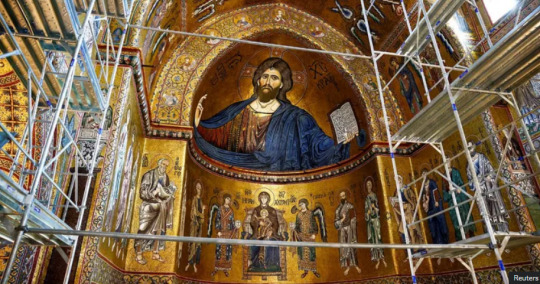
One artifact at a time, this museum in northern Alberta is preserving Canada's military history
Wood Buffalo Military Museum in Fort McMurray cares for thousands of fragile items
Florence’s secret Vasari Corridor opens to the public after €11 million restoration
The Uffizi’s hidden Medici passageway has opened to the public for the first time following an eight-year restoration.
Heritage at risk
UNESCO, the cultural arm of the United Nations, has granted “provisional enhanced protection” to two Ukrainian heritage sites, the Odessa Literary Museum and the National Historical and Memorial Reserve Babyn Yar, as the Russia’s war on Ukraine approaches its three-year anniversary.
Odds and ends
Some Christmas traditions mirror pre-Christian festivities, but some pagan influences may have been overstated.
Christopher Nolan’s next film announced as ‘mythic action epic’ The Odyssey
The Oppenheimer director’s adaptation of Homer is scheduled for release in the summer of 2026, and will feature Tom Holland, Matt Damon, Anne Hathaway and Zendaya
Baby mammoth preserved for 50,000 years is unveiled in Russia’s Siberia
The 50,000-year-old remains of a baby mammoth uncovered by melting permafrost have been unveiled to the public by researchers in Russia’s Siberia region who call it the best-preserved mammoth body ever found.
23 notes
·
View notes
Text
Working Press AM Quickie | The American Prospect | Arena | BOLTS | Capital & Main | Chalkbeat NYC | The City | Common Dreams | The Conversation | The Daily Yonder | Cory Doctorow | Damage | Digby's Hullabaloo | Dissent | Drop Site News | Gothamist | Grist | The Guardian US, UK, AU | Hakai | The Hollywood Reporter | In These Times | The Indypendent | Inequality.org | The Intercept | Jacobin | Ken Klippenstein | KFF Health News | Knowable | Labor Notes | MacGuffin | The Marginalian | The Marshall Project | Michael Hudson | Middle East Eye | Minnesota Reformer | Mother Jones | The Narwhal | New Left Review | New York Focus | ProPublica | Psyche | ScienceAlert | This | Variety | The Village Voice | Vox | The Walrus | Zócalo Public Square | The 74 | +972
2024 BOLTS Election Guide | Judicial Review Tool NYC | Palestine Congress Vienna 2024 | The States Project Podcasts Bad Empanada | Brandon Sutton | David Feldman | ESVN | Left Reckoning | The Letterhack | The Majority Report with Sam Seder* | Matt Binder | Owen Jones | The Rational National | Second Thought | The Serf Times
Nota bene Acronym Finder | Electricity Calculator | Electronic Frontier Foundation | How's My Driving NYC | List of publications and their leanings | Livestream Nature | Open Culture | Progressive Talent Pipeline | Right to Repair | Scaffolding Map NYC | Science Fiction Roundups |States Project | Women's Press Collective | World Inequality Database | Wordle Tips | Wordly
Funny/Useful YouTube Channels Bobby Fingers | Chris Kohler News | CinemaSins | Dark Brandon | The Elephant Graveyard | Professor Dave Explains *Arthur Goldwag interview 27 June 2024 / Corporate control of the government 19 August 2024 **"Only Connect…" by Howard Send #1, #2
8 notes
·
View notes
Text
Slim Step Ladder
Find the best ISO 9001: 2008 Professional Aluminum Slim Step ladder at the lowest price. With Unique strengthening beam incorporated into non-slip treads.
Slim Step Ladder
About Us :
Aluminium Scaffold Towers Limited manufactures and sells top quality Scaffold Towers. We are an ISO9001 accredited manufacturer – one of the very few to achieve the British Standard Kitemark (BS EN 1004 Class 3 Standard) for mobile scaffold towers. The company takes pride in its range of scaffold tower products, all of which are manufactured to the highest quality as well as meeting exacting industry safety standards.
As safety standards within the industry have increased, so we have increased the quality of all our product designs to match:-
The DIY tower incorporates welded frames, quick locking braces and advanced guard railing – with options for height adjustable base plates or height adjustable castor wheels. All of these are new innovations in the DIY market and are made to the same high standards used in our other (trade) ranges.
Click For More Info :
https://www.aluminium-scaffoldtowers.co.uk/product-category/step-ladders/hop-on-slim-step/
Address : Aluminium Scaffold Towers Limited Unit B, Three Pillars Business Park, Station Road, Sutton, Ely, Cambridgeshire, CB6 2RU
Social Media Profile Links-
https://www.instagram.com/astloyal/
https://twitter.com/i/flow/login?redirect_after_login=%2FASTscaffold
https://uk.linkedin.com/in/aluminium-scaffold-tower-2298bb81
0 notes
Text
Scaffolding Tower
Mobile scaffolding, we are suppliers of a wide range of scaffold towers and access equipment for industrial users, builders, trade and DIY
Scaffolding Tower
About Us :
Aluminium Scaffold Towers Limited manufactures and sells top quality Scaffold Towers. We are an ISO9001 accredited manufacturer – one of the very few to achieve the British Standard Kitemark (BS EN 1004 Class 3 Standard) for mobile scaffold towers. The company takes pride in its range of scaffold tower products, all of which are manufactured to the highest quality as well as meeting exacting industry safety standards.
As safety standards within the industry have increased, so we have increased the quality of all our product designs to match:-
The DIY tower incorporates welded frames, quick locking braces and advanced guard railing – with options for height adjustable base plates or height adjustable castor wheels. All of these are new innovations in the DIY market and are made to the same high standards used in our other (trade) ranges.
Click For More Info :
https://www.aluminium-scaffoldtowers.co.uk/
Address : Aluminium Scaffold Towers Limited Unit B, Three Pillars Business Park, Station Road, Sutton, Ely, Cambridgeshire, CB6 2RU
Social Media Profile Links-
https://www.facebook.com/scaffoldtowers.aluminium
https://www.instagram.com/astloyal/
https://twitter.com/i/flow/login?redirect_after_login=%2FASTscaffold
https://uk.linkedin.com/in/aluminium-scaffold-tower-2298bb81
https://www.youtube.com/channel/UC1T-LXtiTi8OHjEQeQAR93w
0 notes
Text
I do think we learn from every game, and I'm also not convinced all games are purely for fun (I'm thinking of flappy bird - and other endless runners that cause more stress than fun, etc.). BUT, it really depends on what we mean by learning. Every time I play a card game with my family, I learn about their play styles, I learn about my kiddo's critical reasoning, I learn to reason critically to beat them, I learn how to connect through fun and losing. When the focus is classroom content learning - I could make a lot of connections (there's math, there's critical thinking) but not all teachers/professors will accept that AND (more importantly) not all players make that skill transfer. So I think even if we play the same game with a young child 1 million times, we (the adult) learn something - even if it's just about the other player. But that doesn't mean that learning will transfer anywhere - so again, the definitions of learning really matter to fully answer this question.
We can borrow bits and pieces of the theories as we see fit. This is why I see so many connections to the broad WPA outcomes that include "Rhetorical Knowledge". I think bits and pieces of every single chapter we read in class fits into rhetorical knowledge. I think rhetorical knowledge is critical to meaningful writing - so I can always borrow bits and pieces of all these chapters to support the connections I want to make, and the ways I pedagogically approach learning design. But, this is not necessary, not required. Huizinga is cited, a lot, but the whole theory isn't picked up. The focus is really on the voluntary nature of play. Sicart and Sutton-Smith include so many pieces that it makes more sense to focus on smaller pieces. The Writing Knowledge Transfer overviewed so much transfer research we cannot possible take it all on - and that's how it was intended. Pick the pieces you need, situate why in your writing.
Intrinsic motivation is alway better - but that doesn't mean it's always the right approach, or the first approach. We need significant buy-in before an assignment can be designed with intrinsic motivation as the center. Starting with extrinsic motivation to break down assumptions may be the best first starting point. I think the GBL is important for the inclusion of culture in their mangle of play. I think that is such an important way to bring even more to the play theories and writing theories we read in class. Who are the players? What play experiences do they bring? What learning experiences do they bring? These are really important questions if we want learning to happen, and we need to work through this, scaffolding them into intrinsic motivation.
Dr. P Check-in Chp 2

Can we learn something from every game? Or are there some games that are purely just meant for fun?
Do all theories need to be present or can it be parts?
The chapter says intrinsic motivation works best for this. Is it still possible to get good results with extrinsic motivation? I think so many of today’s students are so so so extrinsically motivated and don’t want to do something where they get “nothing” in return.
@npfannen
2 notes
·
View notes
Quote
Depending on climate, happenstance, and technology, a body might be around as decaying organic matter for only a matter of weeks or months, a few years at best. It begins to devour itself within minutes, as the enzymes that had once turned food into nutriments start disassembling the body that no longer needs them in their old job. This is autolysis. Bacteria freed from the gut soon afterward also start to devour the flesh; in later stages microbes from the soil and the air join in. Putrefaction. Eisenia fetida—the worm in our compost bins—dines on the carnage in some climes; so do flies and other insects. There are many variations on this theme. Anything that keeps bacteria and chemical reactions from working as well as they might preserves bodies: dry, cold, wet, and sterile conditions. The deserts of Egypt and the high Andes, the frozen tundra of Siberia, the acid bogs of Denmark, tanning agents, and anaerobic conditions—all preserve the dead far longer than anyone had reason to expect. So do the desiccating clay caves of Palermo, famous for their ability to make corpses into mummies that could be dressed up to look ready for the opera. The soil of the cemetery in the old colonial city of Guanajuato yielded up mummies of nineteenth-century cholera victims that have become a major tourist attraction and an emblem of Mexico’s engagement with the dead. But under most conditions, an adult corpse is lucky to survive a decade. Bodies encased in lead fare better than those in wood or in the ground; it helps to die on an empty stomach and with evacuated bowels; it helps if someone has removed the viscera; embalming helps. Collagen and hair do better than other soft tissues. Bones fare better than flesh. how much better again depends on where they lie. In the highly acidic soil of the great seventh- century Anglo- Saxon burial mound at Sutton hoo in Suffolk, for example, only the stains of bones remain; in the more basic soil of Wharram Percy at the edge of the chalk wolds of north Yorkshire, surviving medieval skeletons are in good shape. Generally, the large bones of the leg fare better than the small bones of the foot. But it matters little. The skeletal remains of friends, of enemies, and of strangers are, as has been endlessly rehearsed over thou-sands of years, pretty much indistinguishable. Of course, some may bear the marks of the life that once clothed them: violence, disease, and time itself leave marks. Bones do tell tales. But without dress or some other distinguishing mark, it was hard to tell them apart before the advent of forensic DNA technology and other modern techniques. This is why in pictures of the Last Judgment the more prominent dead are shown wearing their crowns or miters to help distinguish them from the great mass of corpses. Out of context, even animal parts can be mistaken for those of humans, except by experts. Chaucer’s pardoner, one might remember, “hadde pigges bones” in a bottle that the gullible took to be human: the relics of a saint. And after not so long a time, even the bones fall apart: dust to dust. erosion and oxidation see to that. Death proves even the rich man, as Sir Walter Raleigh observed on the scaffold, “a naked beggar which hath interest in nothing, but in the gravel that fills his mouth.” everything is covered over “with these two narrow words, Hic jacet.”
Thomas W. Laqueur - The Work of the Dead: A Cultural History of Mortal Remains
7 notes
·
View notes
Photo

1 of 3 posts featuring artists from #CriminalizeTHIS! Co-curated by Lorenzo Triburgo and Mary Gagler. in 2019, the exhibition explored resistance to #genderpolicing in both the tacit, subtle ways that impact everyday life and through systemic, institutional punishment. Image 1 Peter Clough, ‘Peter (Scaffold)’ @cloughabunga David Andersson, Derek at Harrier Hill IV @davidjandersson Jon Feinstein, Untitled, From "It Follows" @jonfeinstein Guy Woodard, Out Julie Green, First Meal for Kristine Bunch @juliegreen_art Marc Ohrem-Leclef, Jugaad/Of Love and Intimacy @marcleclef Brittany Knapp, Undue Process @brittanyknappart Clark Stoeckley, Defense Arguments @clarkstoeckley Vick Quezada, The Precarity of a Myth @vickquezada 2 Detail, Rowan Renee, ‘No Spirit For Me - Polaroids’ @brooklyntintype 3 Ebenezer Galluzzo, The Right Body @photo.galluzzo Garth Amundson & Pierre Gour, Mrs. & Mrs,@amundsongour Rebecca Hackemann, The Skirt Chaser, uncensored version I @rebeccahackemann Julia Bradshaw, Large pendulous breasts are difficult to photograph @juliabradshaw.art Jessica Burke, I Was Famous Once 4 Kyle Quinn, Gaines (Second Surgery) Bottom: Sara Minsky, lines from a poem i never thought i’d let anyone read @sara_minsky 5 Rebecca Jean Sutton, @nudityandteeth 6 Closing Event Performances: Kevin Quiles Bonilla, Troizel Carr, William Chambers, Francisco Eraso Jr., MK and LO, Ashton Muñiz, Jess Saldaña, Sahar Sepahdari, and Emily Wexler. 7 Closing Performances by @realityhasbeenpostponed and @arshton Not shown in images: Chasing Mania @maricofayre & Zines by Billi London-Gray, Gender Is!, She looks a Sea, The Earth, The Abode of Disproportioned Fictions, Collective Wisdom #QueerArt #TransArt #prisonabolition #resistance #queerresistance #queerliberation #genderqueer #lgbtq #pride #queer #feminist #transgender #trans #nonbinary #equality #queerafAF (at Amos Eno Gallery) https://www.instagram.com/p/CQeoc1jlny-/?utm_medium=tumblr
#criminalizethis#genderpolicing#queerart#transart#prisonabolition#resistance#queerresistance#queerliberation#genderqueer#lgbtq#pride#queer#feminist#transgender#trans#nonbinary#equality#queerafaf
2 notes
·
View notes
Text
Morbid Curiosity and the History of the Audience
The Execution of Charles I
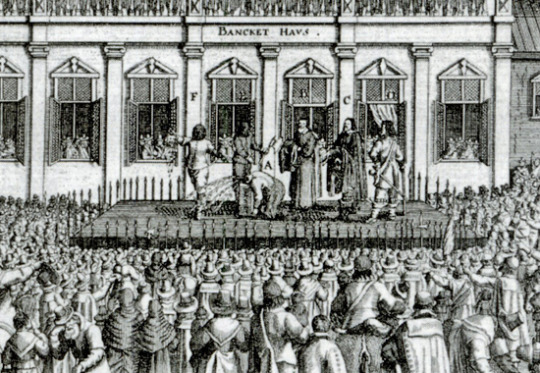
Charles I was King of England, Scotland and Ireland from March of 1625 until his execution in January of 1649. Due to his belief in the Divine Right of Kings, Charles’ rule was filled with quarrel with the English Parliament. In 1642, Charles fought in the English Civil War, was defeated and refused to accept the demands of a constitutional monarchy from his captors. As a result, Charles was tried and convicted for high treason, eventually to be sentenced to a public beheading. In Graham Edwards’ The Last Days of Charles I, he claimed that it was common practice for the severed heads of traitors to be held up and exhibited to the crowd, which did happen in the case of Charles. In a description of his execution, the former King was said to have been led by guards to a scaffold erected in front of the banquet house, where a crowd of spectators were separated by the soldiers in attendance (Carlton, 1995). During the Middle Ages public torture and execution was common, often being regarded as an acceptable form of punishment. The nature and severity of the crime suggested the amount of pain inflicted on the offender. There were few rights given to prisoners, and executions became a widespread, unregulated event attended by large, jeering crowds despite the gruesome nature (History TV, n.d.).
Morbid Curiosity? Why tune into such a gruesome act?
Of course, it’s evident that forms of entertainment in the medieval era are slimmer than what we are presented with today. There was no television, no movies, and lower literacy rates, so what else to do then go out and witness the beheading of your current monarch? Can we actually attribute the large crowds of spectators to the fact that there was just simply, “nothing else to do”, or can we interpret this audience behaviour from a different perspective? Perhaps, we can study the topic of morbid curiosity, a term defined as “an aspect of curiosity that be seen as focused on objects of death and/or violence.” The term is not new, and dates back to Aristotle who states, “[We] enjoy contemplating the most precise images of things whose sight is painful to us.”

From the Middle Ages to Today’s Society
Though accounts from medieval audiences may be hard to cite, we can understand that these early forms of audiences were the beginning stages in the same type of fascination we have today. Our understanding of early audiences would describe events such as an execution, especially one of such a high status figure as Charles I, as organized and planned, collocated in time and space, and roles of authors, performers and spectators being outlined and defined. Of course the performers in this sense taking on a sadistic meaning, with the executioner and the traitor both playing huge, yet presumably unwanted, roles. Thanks to the expansion of technology, unmediated, or smaller, audiences have shifted to mediated ones. From thousands co-located in space to millions around the world co-located in time.

Reddit, a site often popular for some of the controversial content posted, and subreddits such as r/MorbidCuriosity, r/WatchPeopleDie, r/5050 and r/Gore, as the titles suggest, focus heavily, if not entirely on subjects that the morbidly curious would be drawn to. This curiosity itself of these gruesome, often despicable acts may have not changed, as it is apparent that this has been a form of entertainment for thousands of years. Yet, the accessibility has increased with the shift of small to large, digital audiences. Have our motivations for witnessing these events changed? I would argue not, as even these early audiences had choice in whether they should consume such frightful scenes, as we now have choice with other forms of entertainment provided to us. We can simply say that human curiosity and the accumulation of audience viewership have not changed. Morbid curiosity is a decades-old source of entertainment, where audience’s fulfillment of the subject has only been heightened in the wake of the digital era.
As Eric G. Wilson, a Professor of English at Wake Forest University describes,
"The morbidity of sorrow is often a productive sluggishness, a time when the soul slows down, too weary to go on, and takes stock of where it's been and where it's going. During these gloomy pauses, we often discover parts of ourselves we never knew we possessed, talents that, properly activated, enrich our lives.
Sources
Carlton, Charles (1995), Charles I: The Personal Monarch (Second ed.), London: Routledge
Edwards, Graham (1999), The Last Days of Charles I, Stroud: Sutton Publishing
Neal, K. (2013, January 3). Beauty has a dark side. Retrieved from https://news.wfu.edu/2012/02/28/beauty-has-a-dark-side/
Take a look at some of the execution methods of the past (n.d.). Retrieved from https://www.history.co.uk/shows/britains-bloodiest-dynasty/articles/execution-in-the-middle-ages.
2 notes
·
View notes
Text
Lisa Sanaye Dring

Hometown?
Hilo, HI and Reno, NV.
Where are you now?
Los Angeles.
What's your current project?
As a director, I'm taking two shows by Kirsten Vangsness to the Edinburgh Fringe, directing Lauren Yee's Hookman at Cal Rep in the fall, and co-directing a very exciting piece in October that won't be announced for a few weeks. As a writer, my play The Wicked One is getting a reading at Circle X two weeks from now. A new play of mine, A Season, just received its first reading with Rogue Artists Ensemble.
I am Associate Artistic Director of Circle X Theatre Co., so I'm helping make our summer reading series happen. I also co-founded Rogue Lab with Chelsea Sutton and we are just wrapping up our inaugural year of creating 6 new hyper-theatrical works with over 50 artists.
Why and how did you get into theatre?
I think my soul brought me to the theatre well before my personality could catch up. That is to say, the reasons why I initially got into theatre and the reasons why I'm doing it now feel completely different. I first started making theatre as a way to be seen. Now I still do it for that reason, but it's enmeshed with the fact that theatre changes the way I see, think, feel, and love. I make theatre to connect with myself and others in a meaningful way. I first bopped into it in a pre-Kindergarten school play, making my theatrical debut as a 'red bird.'
What is your directing dream project?
I have been working with Ray Yamanouchi for a few years on his piece Tha Chink-Mart and I believe it's ripe for a full production. Ray's awesome and I would love to see his piece get the life it deserves.
What kind of theatre excites you?
Ah. Tough question. I like subject matter, structure, design and performance that leans into places I've not yet explored. I want to think and feel things that I've never thought or felt before, and in new ways. I love theatre that helps us remove any scaffolding we have around our imaginations.
What do you want to change about theatre today?
My work is to create rooms in which people can be brave and share the deepest parts of themselves. The things I would like to focus on changing is how I can do that in the highest possible way, hopefully inspiring people to feel free to do their best work. If and when I run a theatre, I'll probably focus on uplifting the excellence of POC and queer voices. But when I get my a magic wand, I'll use it to free up a ton of cash for art-making.
What is your opinion on getting a directing MFA?
If I had the time and cash I'd be up for it, but I have so many different interests (I'm a writer, actor and director) that it'd be tricky to do one thing for 2-3 years. Training is great, life training is also great. I think an artists benefits from both, and only you know which quantities you'll need of either.
Who are your theatrical heroes?
Jessica Hanna, Jen Kays, Brandon Jacobs-Jenkins, Peter Schumann, Sean Cawelti, Kristina Wong, Kirsten Vangsness, Chekhov, Jackie Sibblies Drury, Mona Heinze, the people who run Soho Rep, Jez Butterworth, Chelsea Sutton, Tane Kawasaki, Chris Bayes, Aitor Basauri, Mark Rylance, Eleanora Duse, my sister (she doesn't make theatre, but who cares).
Any advice for directors just starting out?
Lean into all the things that make you sparkle.
Plugs!
https://www.lisasanayedring.com/ https://www.circlextheatre.org/ http://cleotheoandwu.com https://www.rogueartists.org/rogue-lab
1 note
·
View note
Text
Trailer Reaction
My detailed thoughts and spec. Includes filming spoilers:
Rick: It’s been awhile since we’ve had one of these talks.
He’s obviously talking to Negan. Snore. I’m already sick of his ass.
Shot of Maggie in a white button up overlooking construction of the Hilltop. Still wears her wedding ring. :(
BABY RHEE!!!!!!! MY SKIN IS CLEAR! CROPS ARE FLOURISHING!

More Rick VO of him rubbing in how much better off they all are without Negan. Shots of Rick smiling at Judith frolicking in a field.
Next shot is of Richonne on horseback and Daryl on his bike riding into Hilltop. Supposedly Maggie is refusing to send food to the Sanctuary and Rick and Michonne have to come talk to her about it. Think it might be this scene.
Judith, Michonne, and Michonne’s AMAZING GUNS in a field growing shit:
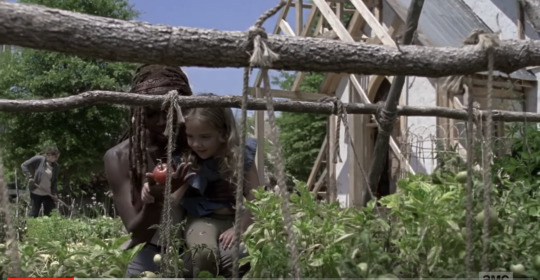
Rick VO: Blah blah blah Negan u suck and we rock.
Walker. Rick and Michonne riding through the abandoned capitol, Rick takes out a walker with a mace and Michonne takes out another with her sword and AMAZING GUNS. *sn: this is the day I went to stalk the filming and spotted the AMAZING GUNS in person.
Shot of sexy AF Aaron strolling through a construction site. He’s bearded and sweaty and in a tight shirt. Daryl is there. Later in the trailer they show a bridge that’s been destroyed, I’m guessing this is all the communities grouping together to build a new one.
Shot of Rick at the Sanctuary, telling them he’ll give them what they need to get on their feet. Random Savior says “Bless you Rick Grimes.” I’m guessing this is when Rick finds out about Maggie starving the Sanctuary.
Shot of Zeke, Carol, Daryl, Sydney, Anne, Father G, Maggie, going into what looks like a museum. Walking over a glass walkway over a pit of walkers. According to spoilers Zeke falls through and nearly dies, Carol freaks out, he is rescued by Daryl.
Shot of Michonne using her AMAZING GUNS to lower an old wagon down the museum stairs. She’s aided by Daryl, Sydney, Carzekiel, Siddiq, Anne, Maggie, Father G, Rick, and Enid. I’m guessing this is right before Zeke’s close call. We know they manage to get the wagon out since there were BTS shots of them driving it out.
Rick walks through a tent city. TSDF said that this was a group of Saviors who’d abandoned the Sanctuary but I think it’s the construction site since we see Tara and Anne walk by.
Negan: blah blah blah I’m a waste of carbon
Walkers.
Shot of a windvane. I point this out because it looks like it has “COMMONWEALTH” written on it. Easter egg/foreshadowing?
Old Man Rick in a rocking chair talking to Maggie. She gives a callback to Rick saying he’d be following her, but didn’t. (she’s wearing the same blue plaid shirt as the scenes in the capitol) Walkers. Maggie fighting walkers in a blue button up shirt over a white tanktop, wearing the same one when she’s walking with Daryl down the road.
Rick at tent city/bridge construction site. Carzekiel are in the background snuggling by the fire (Carol’s wearing a light gray shirt)
Michonne tells Maggie she’s out of line (I’m guessing for starving the Saviors)
Who wore it better? Ha, trick question, the answer is Michonne.
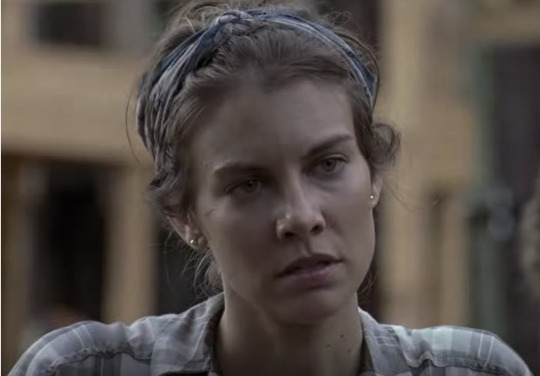

Rick moving through tent city. Anne and Gabriel are hanging out in a tent, Arat and Laura the Saviors are being Sapphic, this shot of Rosita’s butt in these leggings made me gay:

JERRY AND NABILA!!! PURE!!! WHOLESOME!!! INVENTED LOVE!!!
Daryl punches Zach McGowan so hard he goes flying back into a tree. Carol emerges from the tent where Ezekiel was going down on her for hours last night (same gray shirt as when she was cuddling him by the fire) and tells him to stop beating up Captain Vane. Daryl does not stop, instead he picks up a frying pan and bashes him over the head with it.
Daryl VO talking about how back when they were a small group they could do anything. Badass guitar music kicks in. King Rick and Queen Michonne riding through Hilltop looking badass AF. Maggie in the same white button up looking Done and grabbing a wicked looking crowbar. Carol in her gray shirt walking through the woods with a knife raised. Daryl on his bike wearing his boyfriend’s bandana and throwing spears at walkers. Construction site lets loose a stack of logs to roll over some walkers. Rick fighting walkers at the site, in the background are Father G and Anne, Sydney, and Laura the Savior.
Rickyll in a dark, candlelit room having a lovers’ spat. Henry gets in on the Captain Vane disrespect, using the sweet moves that Uncle Morgan taught him to beat his ass with a staff. An asshole Savior dares to lay his hands on Aaron. Wider shot of the same scene shows Daryl fighting Captain Vane right beside him.
Michonne looking radiant, saying that she doesn’t know if “they’re” ever going to forgive each other, followed by a shot of Richonne and Carzekiel walking through the Sanctuary. Spy pro-Negan graffiti. Guessing that Banksy prick is responsible. Asshole Savior who dared to harm Aaron is in a Mexican standoff with Carol. Jerry creeps in holding a gun to back her up. Rick looking pensive. Father G sees a drawing that Anne left him of what looks like the same woman implied to be his wife/GF in his introductory episode. Boots that look like Rick’s shown stumbling with blood dripping. Shot of Daryl sharpening his knife, and I wonder if there’s an in-unverse explanation for his BBH logo tattoo.
Negan continues to waste my and Rick’s time talking.
Shot of the collapsed bridge with the group on one side. Looks like it’s on the way to or from the capitol since they’re wearing the same clothes. Desus stand next to Richonne and Carzekiel. Anne looks creepy AF as she takes a helmet off a walker’s head. Enid looks worried. Arat and (maybe?) Captain Vane erect a crucified walker to act as a scarecrow. Eugene’s first appearance in the trailer, I did not miss him. Maggie and Jesus walk through Hilltop. The latter looks, like, distressingly beautiful. He’s been working out, you can tell, and it’s fucking glorious. Group at the museum, walkers, crossbows, etc. Michonne at Casa Grimes looking at her sword. Tara looking through a pair of binoculars and giving a subtle middle-finger while doing so. Flock of crows taking off in a cornfield from Rick(?) and someone else. Daryl and Carol alone on a loading dock, she puts his head on his shoulder. I’m guessing this is when they have the teased convo about their relationship, and I’m hoping it’s based on comics!Rick and Michonne, where the former calls the latter his “best friend” and says he doesn’t want her to be miserable.
Bridge construction. Rick on his knees out of breath, while behind him group including Dianne, Jerry, Daryl (still dual wielding), Eugene, and Carol charges. Shot of Carol unholstering her gun while the Kingdom squad backs her up. Anne on a walkie talkie with that damned helicopter in the background. Rickyl riding a motorcycle together. Shot of Alden, random Hilltopper, and Jesus looking solemn at Maggie under a scaffold. Spoilers say that the blacksmith Earl Sutton’s son is killed on the museum trip, Gregory gets him drunk and convinces him to attack Maggie, and when she finds out has him executed. Looks like Earl and Brett Butler’s character are there as well. Girl fight between Rosita and Laura. Ladies, just kiss it out.
Anne returns to her junk yard. Graffiti that reads “final warning”. Aaron-attacking-asshole-Savior signs his own death warrant and holds Carol hostage at knife point. Rick and Daryl get off the bike. Daryl looks like he’s having a tantrum. Walkers. Sydney struggles with a walker while Daryl uses the sweet moves he learned from Jesus to take out two walkers with his knives. Walkers menace an unconscious Rick. Maggie fights Gregory. Michonne takes out some walkers with the moonlight glinting off her AMAZING GUNS. More bickering Rickyl. Michonne finds what looks like Lucille but could be Rick’s mace.
MAGNA’S AMAZING GROUP OF LESBIANS Y’ALL. I CAN HARDLY CONTAIN MYSELF.
The token dude/honorary lesbian says he was a music teacher. Magna is hot AF and says she waited tables at a truck stop. Connie is a beautiful Deaf woman who communicates via ASL that she was a journalist. Her butch girlfriend interprets for her. Quick shot of Yumiko, she’s gorgeous. MAGNA’S AMAZING GROUP OF LESBIANS fights walkers and creeps into Casa Grimes.
Finally, Eugene and Rosita are running from a herd of walkers. They cover themselves in mud and lay still as they pass overhead. Hear a creepy voice whisper “Where are they?” Eugene looks like he just shat himself.
22 notes
·
View notes
Photo


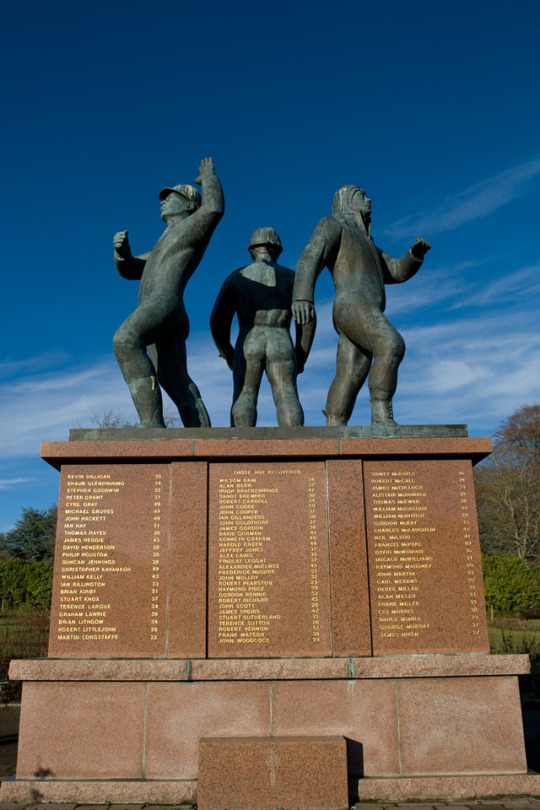
At around ten o'clock in the evening of July 6th 1988 the Piper Alpha oil platform in the North Sea was rocked by a huge explosion.
The 30th anniversary of the disaster will be remembered at a special memorial service tonight in Aberdeen at the Piper Alpha Memorial Garden in Hazlehead Park. The names of all 167 men who lost their lives on July 6 1988 will be read out during the ceremony to be attended by their relatives, friends and representatives from the oil and gas sector.
The vast human tragedy of that day sent shockwaves around the world and forced the industry to take a painstaking look at its practices. On that night, there were more than 220 men on board Piper Alpha, with most in the accommodation section and more than 60 working on the night shift.
After a gas leak on the North Sea platform a series of explosions followed and, minutes later, it was engulfed in a fireball. By the time the rescue helicopters arrived, flames were reaching 300ft and could be seen from 70 miles away. The smoke and fire made evacuation by helicopter or lifeboat impossible, and many people gathered in the accommodation area. Remaining there meant certain death. With the platform ablaze and exploding, some men jumped off from 175ft above the North Sea. Others plunged from lower levels or clambered down ropes and hoses before plummeting into the water. Poundland to stop selling kitchen blades because of rise in knife crime
There were only 62 survivors that night in what remains the world’s worst offshore disaster. An inquiry led by Lord Cullen opened in Aberdeen in January 1989, ended in February the following year, and published its report of several hundred pages nine months after that. It led to North Sea safety being shifted from the Department of Energy to the Health and Safety Executive, and meant that automatic shut-down valves were made mandatory on rigs to starve a fire of fuel.
It's not often I would name all those that perished, but on the 3oth anniversary I think it is only fitting to do so, RIP to the 167......
Robert McIntosh Adams, 39, rigger George Alexander J Anderson, 29, baker Ian Geddes Anderson, 33, dual service operator John Anderson, 45, catering manager Mark David Ashton, 19, trainee technician/cleaner Wilson Crawford A Bain, 34, valve technician Barry Charles Barber, 46, diving consultant Craig Alexander Barclay, 24, welder Alan Barr, 37, electrical technician Brian Philip Batchelor, 44, seaman Amabile Alexander Borg, 51, non-destructive tester Hugh Wallace Brackenridge, 47, roustabout Alexander Ross Colvin Bremner, 38, production operator Eric Roland Paul Brianchon, 32, technician Hugh Briston, 40, scaffolder Henry Brown, 27, welder Stephen Brown, 39, assistant chef/baker Gordon Craib Bruce, 42, helicopter landing officer James Bruce, 52, logger Carl William Busse, 31, directional drilling supervisor David Campbell, 23, cleaner David Allen Campbell, 29, scaffolder Alexander Watt Cargill, 39, electrician Robert Carroll, 34, safety operator Alan Carter, 43, lead production operator Robert Cleland, 33, derrickman Stephen Colin Cole, 40, radio officer Hugh Connor, 35, instrument technician/lecturer John Edward Sherry Cooke, 59, plater John Thomas Cooper, 37, instrument technician William Nunn Coutts, 37, chef William John Cowie, 32, steward Michael John Cox, 26, scaffolder Alan Irvin Craddock, 31, drilling supervisor Edward John Crowden, 47, electrical technician Bernard Curtis, 45, deputy production superintendent Jose Hipolito Da Silva, 26, steward John Stephen Dawson, 38, telecom engineer Eric Deverell, 51, production clerk Alexander Duncan, 51, steward Charles Edward Duncan, 29, floorman Eric Duncan, 49, drilling materials man John Duncan, 33, engineer Thomas Irvine Duncan, 39, roustabout William David Duncan, 38, crane operator David Alan Ellis, 28, steward Douglas Newlands Findlay, 38, supervisor mechanic Harold Edward George Flook, 51, production operator George Fowler, 40, electrical technician Alexander Park Frew, 41, plater Samuel Queen Gallacher, 30, pipe fitter Miguel Galvez-Estevez, 36, assistant chef Ernest Gibson, 45, mud engineer Albert Stuart Gill, 32, roustabout Ian Gillanders, 50, instrument pipe fitter Kevin Barry Gilligan, 35, steward Shaun Glendinning, 24, painter John Edward Thomas Goldthorp, 37, motorman Stephen Robert Goodwin, 22, geologist James Edward Gray Gordon, 38, floorman David Lee Gorman, 41, safety operator Kenneth Graham, 40, mechanical technician Peter John Grant, 31, production operator Cyril James Gray, 49, safety operator Harold Eugene Joseph Green, 44, rigger Michael John Groves, 44, production operator John Hackett, 49, electrical technician Ian Hay, 31, steward Thomas Albert Hayes, 39, rigging supervisor James Heggie, 45, production services superintendent David William Henderson, 28, lead floorman Philip Robert Houston, 35, geologist Duncan Jennings, 28, geologist Jeffrey Grant Jones, 37, assistant driller Christopher Kavanagh, 49, plater William Howat Kelly, 43, electrical technician Ian Killington, 33, steward John Brian Kirby, 51, production operator Stuart Gordon Charles Knox, 37, roustabout Alexander Rodger Laing, 38, steward Terence Michael Largue, 34, scaffolder Graham Lawrie, 39, roustabout Findlay Wallace Leggat, 37, scaffolder Brian Lithgow, 34, photographic technician Robert Rodger Littlejohn, 29, pipe fitter Martin George Longstaffe, 22, logger William Raymond Mahoney, 60, steward John Morrison Martin, 33, rigger Sidney Ian McBoyle, 36, motorman Robert Borland McCall, 39, chief electrician James McCulloch, 51, HVAC technician Alistair James McDonald, 33, mechanical technician Alexander McElwee, 45, plater Thomas O’Neil McEwan, 38, electrical chargehand William George McGregor, 48, leading steward Frederick Thomas Summers McGurk, 51, rigger William Hugh McIntosh, 24, floorman Gordon McKay, 33, valve technician Charles Edward McLaughlin, 46, electrician Neil Stuart Ross McLeod, 47, quality assurance inspector Francis McPake, 49, steel erector/rigger David Allison McWhinnie, 36, production operator Dugald McLean McWilliams, 31, welder Carl Mearns, 20, rigger Derek Klement Michael Millar, 32, supervisor Alan David Miller, 31, industrial chemist Frank Miller, 33, scaffolder John Hector Molloy, 32, engineer Leslie James Morris, 38, platform superintendent Bruce Alexander Ferguson Munro, 29, floorman George Fagan Murray, 37, steward James Cowie Niven, 27, roustabout Graham Sim Noble, 37, materials man Michael O’Shea, 30, electrician Robert Rennie Pearston, 25, mechanic Ian Piper, 38, motorman Wasyl Pochrybniak, 37, lead roustabout Raymond Leslie Price, 59, production operator Neil Pyman, 32, engineer Terence Stephen Quinn, 28, service engineer William Wallace Raeburn, 38, maintenance controller Donald Reid, 44, chargehand engineer Robert Welsh Reid, 27, roustabout Gordon MacAlonan Rennie, 52, process operator Robert Miller Richard, 45, production operator Alan Riddoch, 44, steward Adrian Peter Roberts, 28, roughneck Alexander James Robertson, 50, lead production technician Donald Nicholson Robertson, 54, mechanical technician Gary Ross, 29, roustabout Michael Hector Ryan, 23, roustabout Stanley Sangster, 56, foreman scaffolder James John Dearn Savage, 41, electrical technician Michael Hugh Brodie Scorgie, 28, lead foreman William Alexander Scorgie, 46, pipe fitter John Francis Scott, 26, scaffolder Colin Denis Seaton, 51, offshore installation manager Robert Hendry Selbie, 32, turbo drill engineer Michael Jeffrey Serink, 26, logger Michael Bernard Short, 41, foreman rigger Richard Valentine Skinner, 41, assistant driller William Hamilton Smith, 43, maintenance lead hand James Speirs, 42, mechanical technician Kenneth Stuart Stephenson, 37, rigger Thomas Cunningham Boswell Stirling, 27, cleaner Malcolm John Storey, 38, seaman James Campbell Stott, 40, plumber Jurgen Tilo Stwerka, 36, research chemist Stuart Douglas Sutherland, 21, student/cleaner Terrence John Sutton, 28, mechanical fitter Alexander Ronald Taylor, 57, roustabout Alistair Adam Thompson, 45, telecom engineer Robert Argo Vernon, 51, production operator John Edward Wakefield, 35, instrument technician Michael Andrew Walker, 24, technician Bryan Thomas Ward, 48, rigger Gareth Hopson Watkin, 42, offshore medical attendant Francis John Watson, 38, head chef Alexander Whibley, 28, roustabout Kevan Dennis White, 42, maintenance supervisor Robert Whiteley, 39, roustabout Graham Gill Whyte, 42, aerial rigger James Gilbert Whyte, 53, aerial rigger Alan Wicks, 40, safety supervisor Paul Charles Ferguson Williamson, 24, floorman David Wiser, 65, survey technician John Richard Woodcock, 29, technical clerk
33 notes
·
View notes
Text
Step Ladders
Explore our range of high-quality industrial platform step ladders designed for enhanced safety and efficiency. Find the perfect step ladder for your needs at Aluminium-ScaffoldTowers.co.uk
Step Ladders
About Us :
Aluminium Scaffold Towers Limited manufactures and sells top quality Scaffold Towers. We are an ISO9001 accredited manufacturer – one of the very few to achieve the British Standard Kitemark (BS EN 1004 Class 3 Standard) for mobile scaffold towers. The company takes pride in its range of scaffold tower products, all of which are manufactured to the highest quality as well as meeting exacting industry safety standards.
As safety standards within the industry have increased, so we have increased the quality of all our product designs to match:-
The DIY tower incorporates welded frames, quick locking braces and advanced guard railing – with options for height adjustable base plates or height adjustable castor wheels. All of these are new innovations in the DIY market and are made to the same high standards used in our other (trade) ranges.
Click For More Info :
https://www.aluminium-scaffoldtowers.co.uk/product-category/step-ladders/industrial-platform-step-ladders/
Address : Aluminium Scaffold Towers Limited Unit B, Three Pillars Business Park, Station Road, Sutton, Ely, Cambridgeshire, CB6 2RU
Social Media Profile Links-
https://www.instagram.com/astloyal/
https://twitter.com/i/flow/login?redirect_after_login=%2FASTscaffold
https://uk.linkedin.com/in/aluminium-scaffold-tower-2298bb81
0 notes
Text
Tower Scaffold
Mobile scaffolding, we are suppliers of a wide range of scaffold towers and access equipment for industrial users, builders, trade and DIY.
Tower Scaffold
About Us :
Aluminium Scaffold Towers Limited manufactures and sells top quality Scaffold Towers. We are an ISO9001 accredited manufacturer – one of the very few to achieve the British Standard Kitemark (BS EN 1004 Class 3 Standard) for mobile scaffold towers. The company takes pride in its range of scaffold tower products, all of which are manufactured to the highest quality as well as meeting exacting industry safety standards.
As safety standards within the industry have increased, so we have increased the quality of all our product designs to match:-
The DIY tower incorporates welded frames, quick locking braces and advanced guard railing – with options for height adjustable base plates or height adjustable castor wheels. All of these are new innovations in the DIY market and are made to the same high standards used in our other (trade) ranges.
Click For More Info :
https://www.aluminium-scaffoldtowers.co.uk/
Address : Aluminium Scaffold Towers Limited Unit B, Three Pillars Business Park, Station Road, Sutton, Ely, Cambridgeshire, CB6 2RU
Social Media Profile Links-
https://www.facebook.com/scaffoldtowers.aluminium
https://www.instagram.com/astloyal/
https://twitter.com/i/flow/login?redirect_after_login=%2FASTscaffold
https://uk.linkedin.com/in/aluminium-scaffold-tower-2298bb81
https://www.youtube.com/channel/UC1T-LXtiTi8OHjEQeQAR93w
0 notes